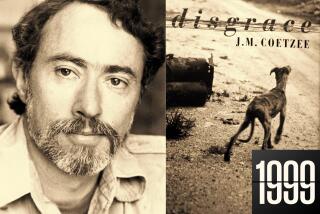The writing on the wall
THE West Bank and the Gaza Strip are like a potent drug. One visit and youâre hooked, and Anne Marie Oliver and Paul Steinberg have the craving. Their book, âThe Road to Martyrsâ Square,â is a strange, seductive hybrid of sociology and memoir that recounts the eight years they spent photographing and studying Palestinian graffiti.
If youâve never been to the Palestinian territories, this might sound like an esoteric or trivial subject. Studying wall scribblings while thereâs a war going on? In fact, graffiti is the bulletin board of the Palestinian intifada, the website where protests are planned, slogans are tested and rage is vented. By studying the changes in this very public expression of Palestinian rhetoric, Oliver and Steinberg have created a unique history.
When the authors arrived in the Gaza Strip in 1988, Palestinian suicide bombers were unheard of; it would be six years before the militant group Hamas adopted this murderous tactic. Oliver and Sternberg stumbled onto a resistance movement undergoing mutation. After 31 years of Israeli occupation, the old nationalist-Marxist model of resistance -- epitomized by Yasser Arafat -- was clearly failing. The dominant ideas of Palestinian life had failed to deliver liberation. Yet an Islamic model of resistance -- epitomized by Hamas and the late Sheik Ahmed Yassin -- had not yet been popularized.
So what draws tens of thousands of young men (and growing numbers of women) to an elaborate death cult? The statistics are shocking enough. The U.S. Agency for International Development -- hardly a pro-Palestinian pressure group -- reported in 2002 that one in five young children in the Palestinian territories suffers from malnutrition. For more than 13% of children under 5 in the Gaza Strip, the problem is so acute that it will affect their growth and mental development.
Even this misery is not enough to explain (let alone justify) blowing oneself up to kill Israelis. Yet political ideas are viral. They spread in debased conditions and -- whatever the other causes -- there can be no question that decades of Israeli military occupation created a soil in which jihadism would thrive.
When the authors first arrived, most Palestinians subscribed to a nationalist ideology. Nationalists revere the peasant and the shepherd and talk in a romantic way about the land. Islamists revere the hajj, the religious pilgrim who relinquishes his earthly possessions to fulfill the commands of God. Nationalism is, of course, far easier to deal with, because nationalists are merely bidding -- however aggressively -- for real estate.
Jihadism, by contrast, bids for souls. It is also far more corrosive of Palestinian society. The greatest victims since the rise of Hamasâ influence on Palestinian life have been not just Israeli civilians but also Palestinian women like Nuha, a female friend of the authors who had once dreamed of going to college and studying poetry but now is ânot allowedâ to leave the house. When they visit her, she has not stepped outside for several years. âShe lived ... behind a heavy iron door that opened only when [her husband] Muhammed came and went.â
By decoding the graffiti that reveres suicide bombers and interviewing the families of such âmartyrs,â the authors have pried open the imaginative universe of the jihadist youth. A suicide bomber, they explain, âsees himself not only as an avenging Ninja, but also as something of a movie star, maybe even a sex symbol -- a romantic figure at the very least, larger than life.â
These killers seek âecstatic obliterationâ because of disturbingly familiar human flaws: superstitious delusion, vanity, tribal identification and rage. Oliver and Steinberg quote a videotaped âfinal testamentâ by one suicide bomber from occupied Gaza: âWe have seen the dunya [physical world], and ... it doesnât amount to anything.â
This vision of Gaza and the West Bank may seem strangely familiar to Los Angelenos: graffiti, tribal warfare, random violence, misogyny, reverence for death and the lionizing of young men who lived fast and died young. When the young men of South-Central Los Angeles are choked off from economic opportunity, when they have no way to advance but through crime, when they feel they have no safe space to call their own, they form gangs, create alternative value structures and behave like maniacs.
Perhaps the most revealing moment in âThe Road to Martyrsâ Squareâ is when the authorsâ friend Ali watches a pirated copy of the movie âBoyz N the Hood.â Ali is entranced; afterward, he refers to his own slice of the West Bank as his âhood,â without a trace of irony. Are Hamas and the militant group Islamic Jihad so different from the Bloods and the Crips? Or do the Palestinians operate in even more desperate circumstances? *
More to Read
Sign up for our Book Club newsletter
Get the latest news, events and more from the Los Angeles Times Book Club, and help us get L.A. reading and talking.
You may occasionally receive promotional content from the Los Angeles Times.







